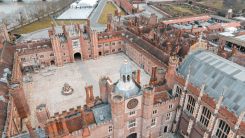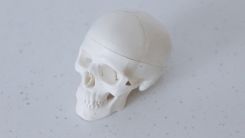
Ron Jefferson


Engineered Bacteria Converts Carbon Waste Into Acetone and Isopropanol

Critically Endangered Hammerhead Shark Spotted Further South of Australia Where They Are Rarely Seen

Male Shorebirds Have Stronger Immune System Than Female Kentish Plovers, Study Claims

Phoenix Zoo Welcomes Female Baby Giraffe That Stands Nearly Six-Foot Tall, Weighs 150-Pound Upon Birth

Sun's Tuesday Far Side Eruption Marks One of the Largest Coronal Mass Ejections in Recent History

Moderna to Develop 3 New Vaccines Including mRNA Treatment for Cancer and Herpes

Obsessively Passionate Workers Experience More Negative Emotions and Stress; Report Lower-Level of Psychological Wellbeing, Study Says

People Who Survived Heart Attack Have Reduced Risk of Developing Parkinson's Disease, Study Claims

Low-Carb Vs. Balanced-Carb Diets: Which Between The 2 Meal Plans Is Better for Weight Loss?

New Cretaceous Lizard With Intact Eyelids Stuck in Amber Discovered After 110 Million Years

Antibiotic Overprescription: Early Antibacterial Treatment Could Decrease Newborns' Gut Microbiome, Increase Antimicrobial Resistance

Astronauts' Brains Rewired During Long-Term Space Missions to Adapt to Extreme Cosmic Environment

Extinct Sea Scorpion That Can Grow 2 Meters Long Discovered in Australia

Nano-Sized Plastics Penetrate, Permeate Human Cell Membranes

Crocodile in Indonesia with Tire Stuck on Its Neck for 6 Years, Finally Freed After Multiple Rescue Operations

Species Can Experience Extinction Twice Before They Completely Go Extinct

First-Ever Luxury Sports Hovercraft Can Drift on Water and Land at 60mph; Available This Summer

Physically Attractive People Have Healthier Immune System, Study Says

DeepMind Applies AI for EPFL Plasma Control and Nuclear Fusion Studies

New Atomic Clock Innovation Record-Breaking on Timekeeping, Loses Only One Second Per 300 Billion Years

Woman From the U.S. Cured of HIV Using a Revolutionary Treatment for Leukemia

Child Robot Nikola Can Convey Six Basic Emotions But Humanoid Lacks a Body

Predecessor of Pontiac Fever Causing Legionella Bacteria Discovered to Infect Animal Cells 2 Billion Years Ago

6 Mummified Peruvian Children Believed to be Sacrificial Escort to Dead Nobleman to the Underworld

Thinning of the Retina Could be an Early Sign of Cognitive Decline, Study Suggests

300-Year-Old Linen Bedsheet Embroidered with Human Hair from a Severed Head Will Be Displayed in London

Peruvian Skull with Strange Metal Implant Baffles Experts: Is It Real or Fake?

Solar Powered Desalination Device Could Solve Drinking Water Crisis

Cancer Treatment: Corn Juice Derived Nanoparticles to Inhibit Mice Tumor Growth
Most Popular

Orionids Meteor Shower Happening Next Week: Where and When To Catch the October Light Show's Peak

Texas Official Shot Down Siren Flood Alert, Complaining That It Might Go Off 'In the Middle of the Night': Report

Nvidia's Jetson Thor Could Make Humanoids Smarter Than Ever

Hellfire Missile Video Reveals MQ-9 Reapers Being Used for Aerial Combat




